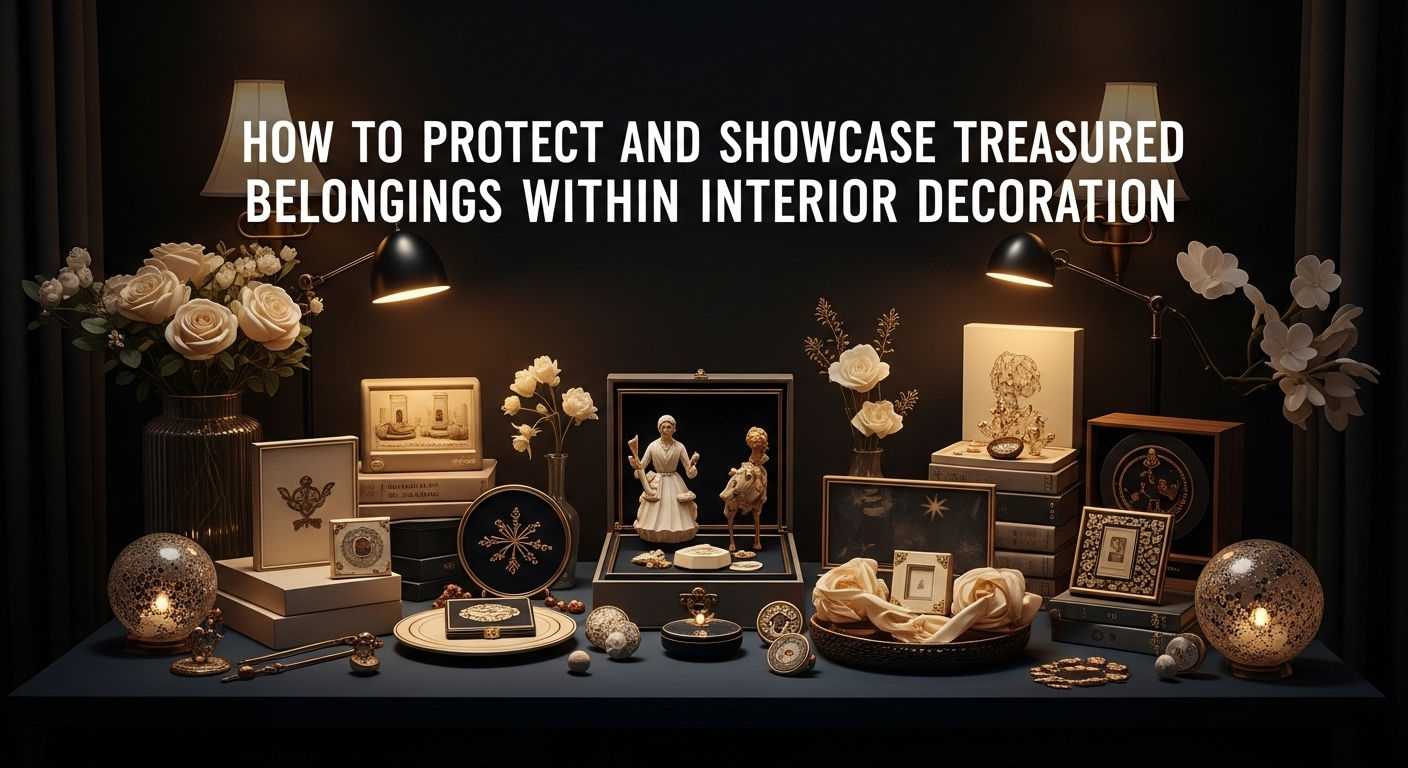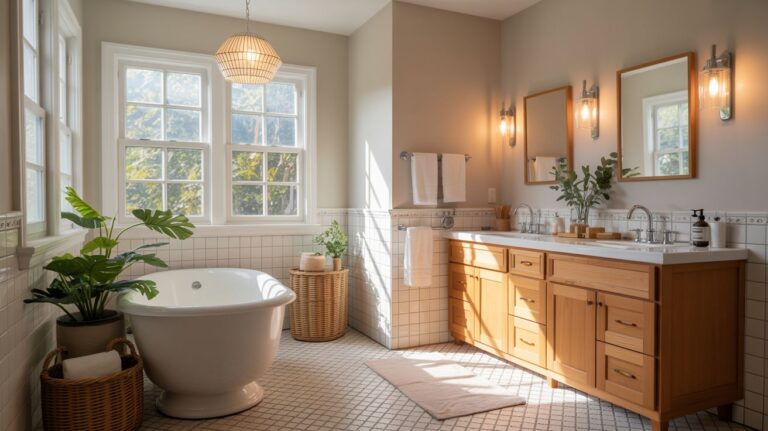How to Protect and Showcase Treasured Belongings Within Interior Decoration
I have been, or can be if you click on a link and make a purchase, compensated via a cash payment, gift, or something else of value for writing this post. As an Amazon Associate, I earn from qualifying purchases. Please read my full Affiliate Disclosure for more information.
Protect your treasured belongings like art: handle them with clean hands, keep them off bright sun, and store them in stable, climate-controlled spaces. Use museum-grade display options with UV‑filtering glass, padded supports, and tamper‑resistant hinges. Choose low‑UV LEDs to light without fading, and rotate pieces to limit exposure. Plan adaptable storage that blends with decor, creating intimate vignettes that tell a story. Tiny details matter, and careful care will reveal more wonders as you explore further.
Key Takeaways
- Use gloves when handling items and place them on stable surfaces away from direct sunlight to prevent fading and oils transfer.
- Control humidity and temperature, employing UV-filtering glass, low-UV LEDs, and proper ventilation to preserve materials.
- Display with purpose: narrate stories, rotate pieces periodically, and avoid overcrowding to minimize damage.
- Choose flexible storage/display solutions with labeled, clear bins and modular units to protect condition and reduce clutter.
- Use protective enclosures, padding, and barriers to deter handling and dust while maintaining accessible, intimate display.
Protecting Delicate Keepsakes: Humidity, UV, and Handling Basics

Humidity, UV exposure, and handling habits quietly determine the fate of delicate keepsakes; control these three factors, and a fragile memory stays intact. You’ll protect antique preservation by limiting light, regulating humidity, and guiding handling. Keep frames away from direct sun, store in stable environments, and use clean hands or gloves to prevent oils. Document exposures, rotate displays, and choose acid-free materials for storage. Handle with care, supporting weight and edges to avoid stress fractures. This discipline preserves sentimental value, letting future generations connect with history. With thoughtful display and careful care, your treasures endure, resonating with enduring significance and tactful restraint.
Smart Storage Solutions That Save Space and Preserve Value
Smart storage isn’t just about cramming more into less space; it’s about protecting value while you reclaim room. You’ll choose space saving furniture that serves dual roles: display and containment. Think modular storage that adapts to your needs, shifting from a bookshelf to a compact cabinet or a wall unit as collections grow. Labeling, clear bins, and standardized components simplify access without chaos. Incorporate hidden compartments for fragile items and open sections for visible favorites, so curation remains intentional. By prioritizing flexible, compact systems, you preserve condition, minimize clutter, and create room for new treasures to flourish.
Materials and Mounting: Safe Ways to Display Heirlooms
Careful materials choice and mounting methods protect heirlooms while letting them shine. You’ll select stable, inert mounting options and acid-free backing to prevent deterioration. When displaying glassware, use padded supports and secure brackets that distribute weight evenly, avoiding contact with sharp edges. Avoid over-fastening that strains frames or crowds pieces. For protecting finishes, choose UV-filtering glass or museum-grade acrylic and position items away from direct sunlight. Choosing display cases with tempered glass, tamper-resistant hinges, and proper ventilation reduces humidity concerns while preserving shine. Keep labeling simple, and rotate pieces gently to minimize handling while maintaining visual balance.
Lighting Techniques to Highlight Memories Without Damage
Lighting can make memories glow without fading them. You’ll balance brightness with preservation by choosing low-UV LEDs and dimmable fixtures, so colors stay true and materials don’t degrade. Position lights to create lighting ambiance that highlights textures without glare, and keep hot spots off delicate surfaces. Use indirect illumination to soften edges and reduce shadows, then add accent lamps to emphasize cherished details. Adjust distance and angle to control shadow play, ensuring each piece speaks without overpowering another. Regularly check mounts and cords, replacing bulbs before they fade. Your display remains vibrant, calm, and securely safeguarded.
Curating Intimate Vignettes: Storytelling Through Display
You shape your space by placing personal articulations where they’ll be seen, not just stored away. Through narrative curation, you guide viewers through a quiet story with each object and its companion memory. Start with intimate shelving that invites touch, then layer meaning with selective objects to weave a clear, concise tale.
Personal Articulations on Display
Walls aren’t just walls in this vignette—they’re a quiet invitation to the stories you’ve lived. You curate shelves, surfaces, and corners to mirror your intimate world, not a showroom. Each artifact earns a deliberate place, a pause before its next impression. Consider cultural significance when selecting pieces: a fragment from travels, a gifted heirloom, a book pressed with memory. Arrange with intention, so contrasts outline dialogue rather than clutter. Allow emotional resonance to surface through lighting, texture, and scale. Your display communicates mood, values, and memory—not merely objects. You invite conversation, reflection, and connection through concise, meaningful articulations.
Narrative Curation Techniques
Narrative curation turns a room into a conversation, guiding you to choose pieces that speak to each other rather than compete for attention. You arrange intimate vignettes by aligning objects with a central theme, then layering meaning through placement, texture, and scale. Color psychology informs mood: warm tones invite closeness, cool hues encourage reflection. Cultural symbolism adds depth, inviting viewers to decipher lineage, memory, and value. Limit clutter to emphasize each story, while echoing motifs across shelves, corners, and surfaces. Purposeful contrasts—soft fabrics against hard frames—highlight relationships. The result is a purposeful, comprehensible narrative you can revisit and reinterpret.
Intimate Object Shelving Tips
Intimate object shelving invites a whisper of story, so start with a clear focal piece and build around it with smaller, complementary objects. You’ll create a narrative by displaying personal artifacts in a deliberate arrangement that signals theme and memory. To keep the display cohesive, think in layers and textures, not random scatter.
- Choose a defining centerpiece.
- Add two supporting items that echo color, material, or era.
- Balance with negative space to invite gaze and reflection.
Maintenance Habits for Longevity of Treasured Objects
You’ll start with a simple routine: regular cleaning to remove dust and grime without harsh scrubbing. Keep your space steady with careful humidity and temperature control, avoiding swings that can weaken materials. Handle objects gently, lifting and supporting them to prevent accidents and wear.
Regular Cleaning Regimens
Regular cleaning isn’t just about sparkle; it’s a smart habit that protects texture, color, and composition over time. You’ll extend cultural significance and preserve sentimental value by gentle, deliberate care.
- Dust with a soft brush or microfiber, moving in long, even strokes.
- Wipe surfaces using appropriate cleaners—lacquered, wood, or glass—never abrasive scrubs.
- Inspect for wear, repairing or documenting changes to track longevity.
Maintain a routine schedule, adjusting frequency to item and material. Store pieces away from direct sun and drafts between cleanings. Your careful habit keeps memories intact and objects cherished, without sacrificing their story or artistry.
Humidity and Temperature Control
Ever wonder how subtle shifts in air can age a keepsake faster than time itself? You’ll tune humidity and temperature to slow deterioration. Maintain steady ranges to avoid mold, cracking, or warping, because even small fluctuations compound damage. Use simple tools: a hygrometer and a thermometer, paired with a reliable thermostat. In artificial environments, position sensitive items away from vents and direct sun, and seal display cases when needed. Regularly record readings to spot trends, and implement climate monitoring routines. Consistent controls protect material integrity, ensuring your treasured objects endure with clarity and character for generations.
Gentle Handling Practices
Gentle handling is the quiet foundation of longevity: with every lift, turn, and placement, you protect fragile details from stress and damage. You create rituals that reduce risk and preserve sentiment over time.
- Use clean, supportive surfaces and two-handed grips when lifting, avoiding jerks that strain joints or materials.
- Align objects gently into their display, keeping weight evenly distributed to prevent stress fractures or warping.
- Practice routine checks for loose components, humidity balance, and dust-free surroundings to sustain sentimental preservation and overall appearance.
Conclusion
You don’t have to choose between beauty and memory. With thoughtful care, your treasured belongings can endure and shine. Respect humidity and light, handle gently, and store smartly. Choose safe mounts and materials that cradle each piece, then curate intimate vignettes that tell your story without crowding it. Maintain routine checks, reframe displays as your memories evolve, and let every object whisper its history. Your home becomes a living cabinet of affection, resilience, and enduring charm.






